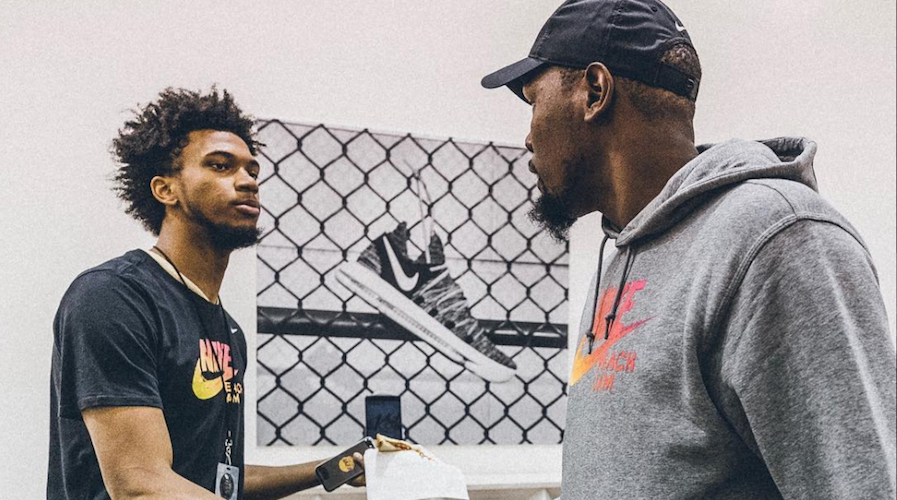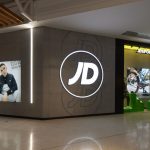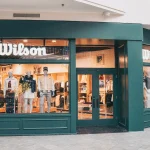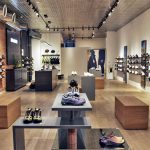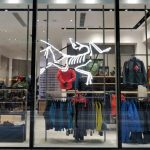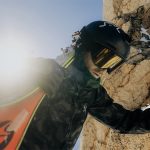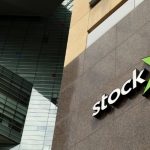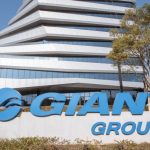While continuing to see strong momentum internationally, particularly in China, in its first quarter ended August 31, Nike Inc. remained unable to reverse a continued slowdown in its home market.
Sales in North America, largely as projected, fell 3 percent in the quarter from a year ago and are expected to decline again in its second quarter. But Nike officials have become less confident that sales can revive in the back half of its fiscal year and said the region’s weakness is now expected to put more pressure on gross margins than previously expected.
“We do anticipate continued marketplace disruption in North America,” said Andrew Campion, Nike’s CFO and EVP, on a conference call with analysts. “And so in the short term, there are implications of that disruption that will likely be beyond our control, for instance, how certain retailers may be responding to some of these challenges, door closures and the precise timing of those potential discontinuities.”
Campion added that efforts as part of the brand’s Consumer Direct Offense initiative to drive deeper connections with consumers in North America and accelerate product launches are expected to drive “a tremendous growth opportunity over the medium to longer term and actually will fuel some of our growth in the short term.”
But he indicated that the uncertainty in the marketplace makes predictions on a sales rebound difficult. Campion added, “Given all of these dynamics, just one quarter into the year, it’s unclear, and I wouldn’t say precisely where North America will land for the full fiscal year.”
Companywide, Nike Inc.’s sales in the quarter were flat at $9.07 billion on a reported and constant currency basis as strong momentum in its international geographies and in its Nike Direct businesses globally was offset by a decline in North America wholesale revenue.
Revenue in the Nike Direct business was up 11 percent globally, driven by online growth of 19 percent, new stores and comp store growth of 5 percent.
Net earnings declined 23.9 percent to $950 million, or 57 cents a share, driven by planned gross margin contraction and a higher effective tax rate, which were partially offset by slight SG&A leverage and a lower average share count.
Results came in well above Wall Street’s consensus estimate of 48 cents a share. Shares of Nike nonetheless were down, off $1.87, or 3.5 percent, to $51.83 that was traced to concerns over North America growth and a more-muted outlook.
In North America, sales for Nike Brand in the quarter were down 2.7 percent to $3.93 billion and were off 3 percent on a currency-neutral basis. The decline was in line with expectations and a “function of short-term promotional headwinds in the broader marketplace, which were partially offset by continued growth in our Nike Direct businesses,” said Campion.
By category on a currency-neutral basis in North America, footwear was down 3 percent to $2.43 billion, apparel gave back 1 percent to $1.3 billion and equipment shed 3 percent to $191 million.
EBIT in the North America region was flat at $1 billion as a short-term contraction in gross margin was offset by lower marketing expense primarily as a result of prior year comparisons. Inventories for the quarter were down 2 percent “as we continue to manage supply and demand tightly,” said Campion.
Also on the call, Trevor Edwards, president of Nike Brand, said the revenue dip reflected ongoing steps to “proactively manage the marketplace supply.”
On the positive side, he noted that momentum continued in the Nike Sportswear business and new innovations such as VaporMax and the LEBRON 15 were well accepted.
“Women’s had a powerful quarter with popular and premium executions from the Chrome Blush, a new collection of stylish workout gear that led to strong performance in the market, to membership accelerators like the Air Society, a network that serves to connect and empower creative-minded women,” said Edwards.
He said that in North America, the focus will be building on the momentum seen in its DTC business and working to “reignite strong momentum” in the region by working with its strategic partners such as Dick’s and Foot Locker to elevating the Nike Brand experience at retail.
“At the same time, we still see a dynamic and promotional landscape, one that is having a pronounced impact on physical retail, especially in light of the continued consumer shifts towards digital,” stated Edwards. “This is exactly why we are focused on elevating those differentiated and better service experiences that consumers are voting for.”
In its digital business, for example, Nike is editing its assortments to focus on the most popular sellers.
“While we expect to see continued shifts in the broader U.S. marketplace, the solutions are clear,” Edwards said. “It’s about leveraging the power of our brand, continuing to tell powerful stories that lift up the Nike Brand and then using that brand strength to drive deeper relationships with consumers as we connect more personally and more directly.”
Edwards concluded, “Fundamentally, we are bullish about the long-term opportunity in North America as consumers continue to accelerate their pursuit for healthy and active lifestyles. We are confident in our ability to extend our leadership position over the long term and reinvigorate growth in this region.”
Campion in the same vein stated that in the short-to-medium term, Nike in North America will “prudently manage risk as we focus on accelerating a shift in the composition of the market to experiences that consumers are increasingly telling us that they love, those being digitally enabled experiences that bring together the best of Nike’s brand, product and services. For Nike, that begins with Nike.com, mobile experiences such as our Nike and SNKRS apps and Nike-owned stores. Our 2X Direct strategy will extend into the broader marketplace through new experiences that we’re creating with strategic partners such as Foot Locker and Dick’s Sporting Goods that will bring the Nike Brand closer to our consumer.”
Among other regions, sales in Greater China for Nike Brand rose 8.6 percent to $1.11 billion while climbing 12 percent on a currency-neutral basis. Double-digit growth was seen across both footwear and apparel and fueled by its Nike Direct businesses. Strong growth also continued through partners in nearly all key categories. EBIT gained 6.2 percent to $394 million as the strong revenue growth was slightly offset by lower gross margin primarily due to significant transactional FX headwinds.
Said Campion, “We see continued momentum in China over the balance of fiscal year ’18 as well as a tremendous opportunity to deliver long-term growth through our new offense.”
Edwards said Nike particularly benefited from its athlete tours, including Cristiano Ronaldo, LeBron James, Kyrie Irving, Kevin Durant and the NBA MVP, Russell Westbrook. He stated, “These tours drove deeper relationship between athletes and their fans throughout the country. This energy can be felt by the 500 million daily users on Tmall, where Nike is the #1 sports brand.”
A Jordan door opened a few months ago on Tmall, which drove more than 2 million shoppers in the first 10 days. Added Edwards, “Our success in China also offers a reminder that no matter what may be happening in the United States retail, Nike is positioned for continued sustainable growth. The power and consistency of our global portfolio gives us tremendous confidence for the Nike Brand going forward.”
In the Europe, Middle East & Africa (EMEA) region, revenues for Nike Brand increased 3.6 percent to $2.34 billion and advanced 5 percent on a currency-neutral basis. The gains were driven by growth in footwear and apparel and all key categories. High double-digit growth was seen in the U.K. and in its Nike Direct businesses, including double-digit comp growth. Adjusting the comparison against prior year events and the impact of a cyber-attack on one of its European logistics providers, currency-neutral revenue growth would have been more in line with recent quarterly trends. In the fourth quarter, Nike’s EMEA sales were up 11 percent on a currency-neutral basis. EBIT in the EMEA region was off 7.0 percent to $451 million, primarily driven by the impact of transactional FX headwinds on gross margin.
In the Asia Pacific & Latin America region, sales were up 5.1 percent for Nike Brand to $1.19 billion and grew 6 percent on a currency-neutral basis. Multidimensional growth was recorded across footwear and apparel, Nike Direct and wholesale, all key categories and most territories. EBIT improved 24.4 percent to $260 million, driven by revenue growth and lower marketing expenses following significant investments in the prior year against the Olympics in Brazil.
At Converse, sales declined 15.6 percent to $483 million and were down 16 percent on a currency-neutral basis. Campion said “high double-digit growth in China was more than offset by a purposeful tightening of supply in North America.” EBIT at Converse tumbled 41.8 percent to $89 million, driven by declining revenue, gross margin contraction from higher closeouts in North America and SG&A leverage.
Companywide gross margin contracted 180 basis points in Q1, primarily driven by 130 basis points of foreign exchange headwinds and to a lesser extent, a higher mix of off-price sales. Those factors were partially offset by lower product costs.
Total SG&A was down 1 percent in Q1 due primarily to an 18 percent decline in marketing costs, driven by prior year investment around key global sporting events as well as phasing of marketing spend in fiscal year ’18. The decline in marketing was mostly offset by an increase in operating overhead due to costs associated with realigning our organization against the Consumer Direct Offense and continued strategic investments to fuel growth, including investment in mobile to expand its Nike and SNKRS apps globally. The Consumer Direct Offense launched in April called for a 2 percent reduction in Nike’s global staff.
The effective tax rate was 11.4 percent in Q1 compared to 2.5 percent for the same period last year, reflecting the tax benefit of stock-based compensation in the current period under the new accounting standard as well as a onetime benefit related to the resolution with the IRS of a foreign tax credit matter in the prior year.
As of August 31, inventories were up 6 percent, driven by a higher average cost per unit primarily due to product mix and to a lesser extent, changes in foreign currency exchange rates and growth in its Nike Direct businesses.
Discussing some key categories, Edwards noted that Nike Basketball is being elevated by its new NBA partnership that saw the brand deliver the “lightest and most breathable NBA Jersey ever” as well as Nike NBA Connected Jersey that “will unlock a brand-new world of connection” for fans. the KYRIE 3 remains the leading top selling performance basketball shoe while the KD 10 “showed incredibly strong sell-through.”
On the apparel side, the Therma Flex Showtime Jacket will mark the first hoodie to be worn on the court during game time. The NBA partnership also supported the release of 8 new NBA exclusive colorways of the Air Force 1 offering.
The Jordan brand’s Jumpman logo will now be seen on NBA jerseys while the brand continues to expand to other countries and areas beyond basketball like women’s footwear. Edwards added, “That said, in North America, within the retro side of the business, we are managing the cadence of our launches while bringing to market fresher stories and expressions that drive demand. Over the balance of the year, we’re focused on new ways of delivering on the exclusivity and the aspiration that is expected by fans of this iconic brand.”
In Running, the Zoom platform saw a strong consumer response from the Pegasus 34 to the Zoom Fly to the Vaporfly 4 percent, which sold out completely in the quarter. Air VaporMax grabbed the leading share in the U.S. at the $150-and-up price point.
Nike Sportswear’s momentum resulted in the largest revenue quarter ever, thanks in part to the iconic styles such as the Presto and the Air Force 1. Cortez and the Air Max Jewell drove women’s offerings in Sportswear and Sportswear overall continued to see high double-digit growth on Nike.com.
Looking ahead, Campion said Nike’s outlook is “generally in line” with guidance provided at the time of its fourth-quarter release. Strong momentum internationally is expected to continue and Nike now expects slightly lesser headwinds from foreign exchange, net of hedging. He added, however, “We believe there will be short-term headwinds within the U.S. retail landscape that will dampen growth. Nike’s primary measure of success in North America in the near term will be driving growth in our Nike Direct businesses and through new Nike consumer experiences with our strategic partners.”
For the second quarter, Nike’s revenues are expected to expand in the low single-digit range with contraction in North America and Converse to be more than offset by robust international growth. For the full year, revenue is expected to climb in the mid-single-digit range.
In Q2, gross margins are projected to contract at approximately the same rate as Q1 with FX continuing to be the single largest driver. For the full year, Campion said it now believes “the challenging dynamics in the U.S. retail landscape could result in our gross margin contracting between 50 and 100 basis points versus prior year. Previously, it anticipated modest contraction by as much as 50 basis points, largely due to FX headwinds in the first half.
Q2 SG&A is expected to grow low double digits. For the full year, SG&A growth is expected to rise in the mid-single-digit range.
“We will continue to manage operating overhead prudently while remaining on the offense, investing to, one, drive brand heat and distinction; two, amplify our launch of new innovative products; and three, build the capabilities required to enable speed and direct connections to consumers,” said Campion.
Campion concluded, “We have operated in dynamic circumstances before, and in every instance, being on the offense and consumer focused has served us well. Our organization is now realigned against our new Consumer Direct Offense, and we’re all energized by the opportunity to ignite yet another horizon of strong, sustainable growth at Nike.”
Photo courtesy Nike

